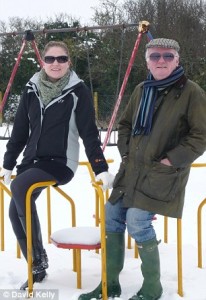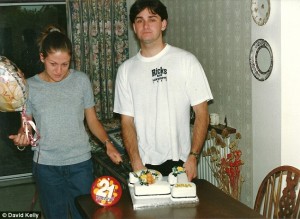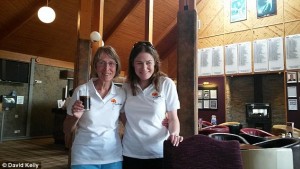EXCLUSIVE: As Jennifer Aniston stars in a new film about the daily agony of living in pain, one father’s heartbreaking story of how the loneliness and despair it causes drove his daughter to suicide.
My daughter’s relentless pain was so bad she committed suicide
By ANNA HODGEKISS FOR MAILONLINE
PUBLISHED: 12:12 EST, 22 February 2015 | UPDATED: 10:22 EST, 23 February 2015
Julia Kelly spent most of her short life racked by pain.
Plagued by excruciating gynaecological complaints from the age of 11, she went on to suffer daily agony from two car accidents – neither of which were her fault.
After the first, 10 years ago, she battled to retain a sense of normality.
But over time, with her body giving up, she struggled to come to terms with how the pain so drastically altered the course of her life.
 |
At 37, when most women dream of having a family, Julia was so immobile she couldn’t tie her own shoelaces.
I AM CHRONIC PAINÂ
Before her death, Julia helped produce a short, but poignant film to help educate others about the real effect of living with chronic pain. Her father David believes the words are a stark reminder of how the condition affects sufferers.You can’t see me,
You probably do not even know I exist,
I am chronic pain,
I wreck lives,
I destroy happiness,
I tear relationships apart, shatter dreams,
I stop careers in their tracks,
I may even take your home and empty your bank account,
And let’s not forget to mention the daily, physical pain I will cause you,
I can appear at any time,
And I do not discriminate,
Beware – one day I may even take your life away.
Forced to move home to her parents and quit her beloved job, the lack of a ‘proper life’ and independence became unbearable for the sociable and extremely intelligent charity worker.
But it was the second car accident two years ago, which left her fearing incontinence, that was the final straw.
Three months ago, on November 2, Julia ended her life aged just 39, no longer able to bear her constant suffering.
She left no note, but her family are in no doubt the agony she endured for several years – and the loneliness and despair it brought – are to blame.
Her father David, 72, is now running the pain charity she founded to help others battling the condition to realise they are not alone.
He hopes that by doing so, others may be spared the tragedy and heartache his family has endured.
More than 1.5 billion people worldwide – or around one in seven of us – suffer from chronic pain, according to the American Academy of Pain Medication.
 Julia, with her father, David. |
The condition is defined as pain that lasts as three or more months.
Despite these overwhelming statistics, chronic pain remains one of the most poorly understood and underfunded services in global healthcare.
As a result, trying to get effective treatment can be lengthy and frustrating, leaving those affected feeling helpless and in some cases, suicidal.
But now, thanks to a new Hollywood film starring Jennifer Aniston, it has been thrust into the limelight – to the relief of families such as the Kellys, who hope it will raise awareness of the brutal reality of living and caring for someone with the condition.
In the film, Aniston plays Claire Bennett, who suffers horrific chronic pain following a car accident.
Her physical pain is evident in the scars that line her body and the way she carries herself, wincing with each tentative step.
Claire is no good at hiding her emotional pain either. Blunt to the point of searing insult, anger seethes out of her with nearly every interaction.
She has driven away her husband and her friends – and even her chronic-pain support group has kicked her out.
It is only the suicide of Nina, one of her fellow chronic-pain group members, that triggers her to confront her life with pain – and how to deal with it head on.
The film spares none of the misery that sufferers deal with on a daily basis: the agony of taking just a few steps, the torture of sitting in a car as it goes over a speed bump, the relentless insomnia – and the in some cases, the anger towards the person or situation that caused the pain.
Tragically for Julia, pain won – but her family are determined to help others suffering with chronic pain avoid the same fate.
For David and his wife Valerie, 74, the film was particularly poignant and raw as they attended a screening just three months to the day that Julia had taken her own life.
‘Ironically, our train trip from Northamptonshire to London was held up for 30 minutes due to someone jumping off a bridge onto the railway line,’ David told MailOnline.
‘With chronic pain – or a mental health issue – it’s so important to realise you are not alone.
‘There are people who have trodden this path before and can help you. And I realise now that unless you have been through it, you will never understand it.
‘The cruel fact is that this condition affects one in seven people and has a massive impact on social structure, working environment, education and employment.
‘Teachers and employers, for example, are often not aware of chronic pain and think sufferers are perhaps lazy, when actually the person is suffering very debilitating pain that no one can see.
‘Whereas you can see a broken arm or a wheelchair, you can’t see chronic pain.’Â
 Julia celebrating her 21st birthday with Brett. She suffered from severe endometriosis from the age of 16 |
David and Valerie feel that in Claire, Jennifer Aniston played a powerfully moving character.
‘We saw a very close resemblance to Julia so often,’ he said. ‘The way her body moved, the way she walked – every movement was so evidently painful.
‘Travelling in a vehicle was also such agony, her facial expressions showed the pain all so often.’
And as also becomes apparent in the film, life with chronic pain can be incredibly lonely.
‘The life you had – work, going out with friends – has gone,’ said David, a retired commercial manager.
‘But everyone else continues with their life. They work all week, see their partners on the weekend.
‘Julia didn’t have that – and unless you go through that bereavement process properly for the life you once had – and come to terms with the fact it’s gone – it will slowly eat away at you until you crack.
‘Whenever I see a young girl, probably married, pushing a pushchair down the street, I feel sad that Julia never had that.
‘A few times, she said she wished she had never been born, that she’d never had a good life because of the pain.
 Julia and her mother, Valerie |
Diagnosed with severe endometriosis at 16 after suffering crippling period pains, Julia was given hormonal medication so powerful it induced a ‘mock menopause’.
David said: ‘Because of her terrible endometriosis when she was a teenager, she often missed out on fun nights out with her friends, relationships were impossible and the pain impacted hugely upon her education.’
Despite missing huge chunks of her education because of it, she was overjoyed to secure a job with a local charity at the age of 28.
Writing on the charity’s website before her death, Julia said: ‘I was so proud to finally be working full time and enjoying life, my symptoms became manageable and I returned to work and got my very own first home.’Â
But in July 2005 she was involved in a car accident – and, unbeknown to her at this point, she would be in pain every day for the rest of her life.
While for the first few years, the pain was manageable, by May 2010, Julia was in agony.
‘She said the pain was like red hot pokers in her leg,’ said David. ‘It hurt to stand, it hurt to sit – she needed cushions for everything.’
Unable to stand, she could only crawl around her flat on her hands and knees.
By the July, the pain forced Julia to abandon life as she knew it.Â
‘She had to move home – and I don’t think she ever came to terms with it – it was like a bereavement,’ said David.
MY LIFE FELT AS THOUGH IT WAS SPIRALLING OUT OF CONTROLÂ
By May 2010, five years after her first car accident, Julia’s pain was so bad she was unable to stand – and she could only move around her flat by crawling on her hands and knees.By the July, it forced her to abandon life as she knew it.
Writing for her charity website in 2012, she said: ‘Life became a blur of hospital appointments and I was put on heavy medication to help with the pain, including tramadol, cocodamol, ibuprofen, diazepam, amitriptyline and gabapentin.
‘My life felt as though it was spiralling completely out of control, the sheer pain and meds meant I could no longer drive, so I became totally reliant upon my recently retired parents to ferry me to my never ending stream of medical appointments.
‘I could no longer manage living on my own so once more, my loving parents came to the rescue, took me in and became my carers.
‘Not being able to work meant having to give up the home I’d worked so hard for, and my much loved and taken for granted independence evaporated right there and then. I felt like I was losing my identity.
‘I felt totally useless, a complete burden on everyone.
‘Feelings of hopelessness, loneliness and despair prevailed.
‘Despite a loving family, great friends and my faithful cat Milly, I felt totally useless, a complete burden on everyone and, quite frankly, an emotional basket case.
‘Night times were the worst – they seemed so long and I couldn’t sleep for the pain.
‘I was lucky if I got a couple of hours sleep so it wasn’t long before the effects of sleep deprivation kicked in, and I found myself turning into a person I hardly recognised anymore, so irritable and angry.’
After a wealth of tests, which revealed toxic liquid had been passing from one of the discs in her spine onto the nerve roots causing pain, she underwent surgery to remove two discs.
Along the way, she found several coping strategies including psychology sessions, hypnotherapy, yoga, meditation and osteopathy.
Despite the pain Julia retained a glimmer of hope that one day, her life might be able to return to some kind of normality.
But in a cruel twist of fate, lightening did strike twice.
In March 2013, Julia was involved in a second car accident when, once again, someone drove into her car.
Her injuries meant she needed major surgery to re-fuse her lower spine.
‘After this accident, she was in absolute pain all of the time,’ said David.
‘From then, up to her death in November 2014, Julia had 72 appointments with a mixture of consultants, doctors, physiotherapists and pain clinics.
‘In terms of her quality of life, she was existing, not living.
‘She couldn’t even lace her shoes up or get dressed without help and some of the strong pain medication made her incoherent.
‘There were no holidays. Her days consisted of being showered by lunchtime, a bit of charity work and then us taking her to the shops before making her dinner.’
Julia was also left with problems with her bowel and feared she may become reliant on a colostomy bag.
‘It was the bowel problems that were the last straw,’ said David. ‘She felt if she lost her dignity, she would have lost everything. The carpet was pulled from under her.
(Click here to see video titled, “Julia’s story: her experience with Chronic Pain before her death”).
‘Until the second accident, she felt she could just about keep up with life, perhaps get a part-time job, but these dreams were then destroyed.’
On top of this, there was the stress of claiming benefits and work tribunals.
Despite overwhelming medical evidence to support her claim, Julia was forced to endure three tribunals – ordeals which only hampered her recovery, her family believes.
The cruel irony was that while Julia was in fact desperate to work, she was made to feel she was exaggerating the pain she was in.
‘People just don’t understand how crippling it can be,’ said David.
Now, three months after Julia’s death and with her inquest next month, he believes he missed signs that his daughter was severely depressed.
‘When you have the benefit of hindsight, it is so easy,’ he said.
‘We always supported Julia, cared for her and helped her financially. But she was very good at hiding things from us.
‘We could see she was in pain, she couldn’t sleep and how each step was excruciatingly painful for her, but we did not understand the mental anguish she was going through.
‘Looking back, it’s so stupidly, blatantly obvious that she was depressed. It didn’t cross our minds – and she kept it from us.
‘We later found out she’d told a friend it would destroy us if we knew. We are getting on a bit and I fear Julia felt – wrongly – she would become a burden to us.’
Just a month before her death, he and Julia went away together for a few days.
‘I felt she was trying to build up the courage to tell me something, but she just couldn’t get the words out,’ said David.
‘The next month, she had gone.’
Does he wish he had done more?
‘Looking back, you can beat yourself up – my wife and I always wonder if we could have done more,’ he said.
‘But in real terms, we couldn’t take the pain away and we couldn’t stop it getting any worse. We couldn’t help the loneliness.’
However he believes Julia’s decision to end her life was ‘totally on the spur of the moment’.
‘On the Tuesday before she died, Valerie had dinner with her and she seemed fine,’ said David.
‘But she had been hounded by the Department for Work and Pensions over some payments she owed and I suppose, with the pain, her patience finally exploded.’
The family first became aware something was wrong when Julia failed to arrive for Sunday dinner.
‘She’d been back at her own flat that we’d kept paying for so she had somewhere to go for space,’ explained David. ‘Although most of the time she lived with us, as she was so immobile.’
At 6.30pm, two hours after Julia was due to arrive back, both David and his son Brett, 42, sent her a text.
When they received no reply, a call to a friend of Julia’s who lived nearby revealed her car was there and the lights in the flat were on.
Feeling uneasy, David and Brett drove the 20 minutes to Julia’s flat.
‘We went around the back of the house and through the blind we could see her lying on the settee, not moving,’ David said.Â
‘Brett could see what had happened. We called the police.’
In the horrific three months since that day, David has focused his energy on building up the charity Julia founded, A Way With Pain.
‘In 2012, she came to me saying she wanted to do something proactive, explaining there really wasn’t anything out there to help people like her,’ he said.
‘The charity was started to create awareness of chronic pain and support those affected – and I became involved to support her.
‘Now I’m keeping going as a legacy to Julia.
‘And while I find I can lose myself in the charity work, which helps with the grief, my poor wife is not so fortunate.’
Going forward, the family hopes the website will bring solace to others living with – or caring for someone with – chronic pain.
‘It’s a place where people can visit, find comfort and share their experiences on the forum, if they so wish,’ said David.
‘Hopefully it can eliminate some of the fear, frustration, loneliness and isolation that can be felt when living and dealing with chronic pain on a daily basis.’

